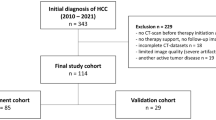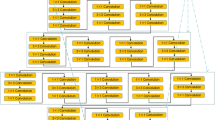Abstract
Treatment of hepatocellular carcinoma (HCC) with Y90 radioembolization segmentectomy (Y90-RE) demonstrates a tumor dose–response threshold, where dose estimates are highly dependent on accurate SPECT/CT acquisition, registration, and reconstruction. Any error can result in distorted absorbed dose distributions and inaccurate estimates of treatment success. This study improves upon the voxel-based dosimetry model, one of the most accurate methods available clinically, by using a deep convolutional network ensemble to account for the spatially variable uptake of Y90 within a treated lesion. A retrospective analysis was conducted in patients with HCC who received Y90-RE at a single institution. Seventy-seven patients with 103 lesions met the inclusion criteria: three or fewer tumors, pre- and post treatment MRI, and no prior Y90-RE. Lesions were labeled as complete (n = 57) or incomplete response (n = 46) based on 3-month post treatment MRI and divided by medical record number into a 20% hold-out test set and 80% training set with 5-fold cross-validation. Slice-wise predictions were made from an average ensemble of models and thresholds from the highest accuracy epochs across all five folds. Lesion predictions were made by thresholding all slice predictions through the lesion. When compared to the voxel-based dosimetry model, our model had a higher F1-score (0.72 vs. 0.2), higher accuracy (0.65 vs. 0.60), and higher sensitivity (1.0 vs. 0.11) at predicting complete treatment response. This algorithm has the potential to identify patients with treatment failure who may benefit from earlier follow-up or additional treatment.




Similar content being viewed by others
Availability of Data and Material
Not applicable.
Code Availability
Not applicable.
References
Golabi P, Fazel S, Otgonsuren M, Sayiner M, Locklear CT, Younossi ZM. Mortality assessment of patients with hepatocellular carcinoma according to underlying disease and treatment modalities. Medicine. 2017;96(9):e5904. https://doi.org/10.1097/MD.0000000000005904
Padia SA, Lewandowski RJ, Johnson GE, et al. Radioembolization of hepatic malignancies: background, quality improvement guidelines, and future directions. J Vasc Interv Radiol. 2017;28(1):1-15. https://doi.org/10.1016/j.jvir.2016.09.024
Salem R, Lewandowski RJ, Mulcahy MF, et al. Radioembolization for hepatocellular carcinoma using Yttrium-90 microspheres: a comprehensive report of long-term outcomes. Gastroenterology. 2010;138(1):52-64. https://doi.org/10.1053/j.gastro.2009.09.006
Kim SP, Cohalan C, Kopek N, Enger SA. A guide to 90Y radioembolization and its dosimetry. Phys Med. 2019;68:132-145. https://doi.org/10.1016/j.ejmp.2019.09.236
Kunnen B, van der Velden S, Bastiaannet R, Lam MGEH, Viergever MA, de Jong HWAM. Radioembolization lung shunt estimation based on a 90 Y pretreatment procedure: A phantom study. Med Phys. 2018;45(10):4744-4753. https://doi.org/10.1002/mp.13168
Chiesa C, Mira M, Maccauro M, et al. Radioembolization of hepatocarcinoma with (90)Y glass microspheres: development of an individualized treatment planning strategy based on dosimetry and radiobiology. Eur J Nucl Med Mol Imaging. 2015;42(11):1718-1738. https://doi.org/10.1007/s00259-015-3068-8
Malhotra A, Liu DM, Talenfeld AD. Radiation segmentectomy and radiation lobectomy: A practical review of techniques. Tech Vasc Interv Radiol. 2019;22(2):49-57. https://doi.org/10.1053/j.tvir.2019.02.003
Villalobos A, Cheng B, Wagstaff W, et al. Tumor-to-Normal Ratio Relationship between Planning Technetium-99 Macroaggregated Albumin and Posttherapy Yttrium-90 Bremsstrahlung SPECT/CT. J Vasc Interv Radiol. February 2021. https://doi.org/10.1016/j.jvir.2020.12.023
Chansanti O, Jahangiri Y, Matsui Y, et al. Tumor Dose Response in Yttrium-90 Resin Microsphere Embolization for Neuroendocrine Liver Metastases: A Tumor-Specific Analysis with Dose Estimation Using SPECT-CT. J Vasc Interv Radiol. 2017;28(11):1528-1535. https://doi.org/10.1016/j.jvir.2017.07.008
Eaton BR, Kim HS, Schreibmann E, et al. Quantitative dosimetry for yttrium-90 radionuclide therapy: tumor dose predicts fluorodeoxyglucose positron emission tomography response in hepatic metastatic melanoma. J Vasc Interv Radiol. 2014;25(2):288-295. https://doi.org/10.1016/j.jvir.2013.08.021
Kao Y-H, Steinberg JD, Tay Y-S, et al. Post-radioembolization yttrium-90 PET/CT - part 2: dose-response and tumor predictive dosimetry for resin microspheres. EJNMMI Res. 2013;3(1):57. https://doi.org/10.1186/2191-219X-3-57
Thamboo TP, Tan K-B, Wang S-C, Salto-Tellez M. Extra-hepatic embolisation of Y-90 microspheres from selective internal radiation therapy (SIRT) of the liver. Pathology. 2003;35(4):351-353. https://doi.org/10.1080/0031302031000152892
Xiao Y, Roncali E, Hobbs R, et al. Toward Individualized Voxel-Level Dosimetry for Radiopharmaceutical Therapy. Int J Radiat Oncol Biol Phys. 2021;109(4):902-904. https://doi.org/10.1016/j.ijrobp.2020.08.026
Kafrouni M, Allimant C, Fourcade M, et al. Retrospective Voxel-Based Dosimetry for Assessing the Ability of the Body-Surface-Area Model to Predict Delivered Dose and Radioembolization Outcome. J Nucl Med. 2018;59(8):1289-1295. https://doi.org/10.2967/jnumed.117.202937
Cheng B, Villalobos A, Sethi I, et al. Determination of Tumor Dose Response Thresholds in Patients with Chemorefractory Intrahepatic Cholangiocarcinoma Treated with Resin and Glass-based Y90 Radioembolization. Cardiovasc Intervent Radiol. April 2021. https://doi.org/10.1007/s00270-021-02834-0
Garin E, Tselikas L, Guiu B, et al. Personalised versus standard dosimetry approach of selective internal radiation therapy in patients with locally advanced hepatocellular carcinoma (DOSISPHERE-01): a randomised, multicentre, open-label phase 2 trial. Lancet Gastroenterol Hepatol. 2021;6(1):17-29. https://doi.org/10.1016/S2468-1253(20)30290-9
Tran-Gia J, Salas-Ramirez M, Lassmann M. What You See Is Not What You Get: On the Accuracy of Voxel-Based Dosimetry in Molecular Radiotherapy. J Nucl Med. 2020;61(8):1178-1186. https://doi.org/10.2967/jnumed.119.231480
Kathiravelu P, Sharma A, Sharma P. Understanding Scanner Utilization With Real-Time DICOM Metadata Extraction. IEEE Access. 2021;9:10621-10633. https://doi.org/10.1109/ACCESS.2021.3050467
Kathiravelu P, Sharma P, Sharma A, et al. A DICOM Framework for Machine Learning and Processing Pipelines Against Real-time Radiology Images. J Digit Imaging. 2021;34(4):1005-1013. https://doi.org/10.1007/s10278-021-00491-w
Braat AJAT, Smits MLJ, Braat MNGJA, et al. 90Y hepatic radioembolization: an update on current practice and recent developments. J Nucl Med. 2015;56(7):1079–1087. https://doi.org/10.2967/jnumed.115.157446
Lencioni R, Montal R, Torres F, et al. Objective response by mRECIST as a predictor and potential surrogate end-point of overall survival in advanced HCC. J Hepatol. 2017;66(6):1166-1172. https://doi.org/10.1016/j.jhep.2017.01.012
Llovet JM, Lencioni R. mRECIST for HCC: Performance and novel refinements. J Hepatol. 2020;72(2):288-306. https://doi.org/10.1016/j.jhep.2019.09.026
Yushkevich PA, Pluta J, Wang H, Wisse LEM, Das S, Wolk D. IC-P-174: Fast Automatic Segmentation of Hippocampal Subfields and Medial Temporal Lobe Subregions In 3 Tesla and 7 Tesla T2-Weighted MRI. Alzheimers Dement. 2016;12:P126-P127. https://doi.org/10.1016/j.jalz.2016.06.205
Yushkevich PA, Piven J, Hazlett HC, et al. User-guided 3D active contour segmentation of anatomical structures: significantly improved efficiency and reliability. Neuroimage. 2006;31(3):1116-1128. https://doi.org/10.1016/j.neuroimage.2006.01.015
Li X, Wang W, Hu X, Yang J. Selective Kernel Networks. In: 2019 IEEE/CVF Conference on Computer Vision and Pattern Recognition (CVPR). IEEE; 2019:510–519. https://doi.org/10.1109/CVPR.2019.00060
Villalobos A, Soliman MM, Majdalany BS, et al. Yttrium-90 Radioembolization Dosimetry: What Trainees Need to Know. Semin Intervent Radiol. 2020;37(5):543-554. https://doi.org/10.1055/s-0040-1720954
Gabr A, Riaz A, Johnson GE, et al. Correlation of Y90-absorbed radiation dose to pathological necrosis in hepatocellular carcinoma: confirmatory multicenter analysis in 45 explants. Eur J Nucl Med Mol Imaging. 2021;48(2):580-583. https://doi.org/10.1007/s00259-020-04976-8
Mikell JK, Mahvash A, Siman W, Baladandayuthapani V, Mourtada F, Kappadath SC. Selective Internal Radiation Therapy With Yttrium-90 Glass Microspheres: Biases and Uncertainties in Absorbed Dose Calculations Between Clinical Dosimetry Models. Int J Radiat Oncol Biol Phys. 2016;96(4):888-896. https://doi.org/10.1016/j.ijrobp.2016.07.021
Sarwar A, Kudla A, Weinstein JL, et al. Yttrium-90 radioembolization using MIRD dosimetry with resin microspheres. Eur Radiol. 2021;31(3):1316-1324. https://doi.org/10.1007/s00330-020-07231-8
Stephens RW, Tredwell GD, Knox KJ, et al. 99mTc-radiolabeled composites enabling in vivo imaging of arterial dispersal and retention of microspheres in the vascular network of rabbit lungs, liver, and liver tumors. Int J Nanomedicine. 2019;14:889-900. https://doi.org/10.2147/IJN.S187153
Kennedy AS, Nutting C, Coldwell D, Gaiser J, Drachenberg C. Pathologic response and microdosimetry of (90)Y microspheres in man: review of four explanted whole livers. Int J Radiat Oncol Biol Phys. 2004;60(5):1552-1563. https://doi.org/10.1016/j.ijrobp.2004.09.004
Chiesa C, Bardiès M, Zaidi H. Voxel-based dosimetry is superior to mean absorbed dose approach for establishing dose-effect relationship in targeted radionuclide therapy. Med Phys. 2019;46(12):5403-5406. https://doi.org/10.1002/mp.13851
Kao YH, Hock Tan AE, Burgmans MC, et al. Image-guided personalized predictive dosimetry by artery-specific SPECT/CT partition modeling for safe and effective 90Y radioembolization. J Nucl Med. 2012;53(4):559-566. https://doi.org/10.2967/jnumed.111.097469
Garin E, Rolland Y, Laffont S, Edeline J. Clinical impact of (99m)Tc-MAA SPECT/CT-based dosimetry in the radioembolization of liver malignancies with (90)Y-loaded microspheres. Eur J Nucl Med Mol Imaging. 2016;43(3):559-575. https://doi.org/10.1007/s00259-015-3157-8
Kao YH, Tan EH, Ng CE, Goh SW. Yttrium-90 time-of-flight PET/CT is superior to Bremsstrahlung SPECT/CT for postradioembolization imaging of microsphere biodistribution. Clin Nucl Med. 2011;36(12):e186-7. https://doi.org/10.1097/RLU.0b013e31821c9a11
Tafti BA, Padia SA. Dosimetry of Y-90 Microspheres Utilizing Tc-99m SPECT and Y-90 PET. Semin Nucl Med. 2019;49(3):211-217. https://doi.org/10.1053/j.semnuclmed.2019.01.005
Author information
Authors and Affiliations
Contributions
William Wagstaff: conceptualization, lead; data curation, lead; formal analysis, lead; investigation, lead; methodology, lead; project administration, lead; resources, lead; software, lead; visualization, lead; writing–original draft, lead; writing–review and editing, lead. Alex Villalobos: conceptualization, equal; data curation, equal; formal analysis, equal; investigation, equal; resources, equal; software, supporting; visualization, supporting; writing–original draft, supporting; writing–review and editing, supporting. Judy Gichoya: conceptualization, equal; methodology, equal; project administration, lead; resources, equal; supervision, lead; validation, equal; writing–original draft, lead; writing–review and editing, lead. Nima Kokabi: conceptualization, equal; methodology, equal; project administration, lead; resources, equal; supervision, lead; validation, equal; writing–original draft, lead; writing–review and editing, lead.
Corresponding author
Ethics declarations
Ethics Approval
This retrospective chart review study involving human participants was in accordance with the ethical standards of the institutional and national research committee and with the 1964 Helsinki Declaration and its later amendments or comparable ethical standards. The Human Investigation Committee (IRB) of Emory University approved this study.
Consent to Participate
Not applicable.
Consent for Publication
Not applicable.
Conflict of Interest
The author, Nima Kokabi, MD, conducts Y-90 radioembolization research partially funded by Sirtex Medical Ltd.
Additional information
Publisher's Note
Springer Nature remains neutral with regard to jurisdictional claims in published maps and institutional affiliations.
This manuscript data was presented as an oral presentation at the 2021 Society for Imaging Informatics in Medicine Annual Meeting.
The work has not been previously published and is not under review elsewhere for publication.
Rights and permissions
Springer Nature or its licensor (e.g. a society or other partner) holds exclusive rights to this article under a publishing agreement with the author(s) or other rightsholder(s); author self-archiving of the accepted manuscript version of this article is solely governed by the terms of such publishing agreement and applicable law.
About this article
Cite this article
Wagstaff, W.V., Villalobos, A., Gichoya, J. et al. Using Deep Learning to Predict Treatment Response in Patients with Hepatocellular Carcinoma Treated with Y90 Radiation Segmentectomy. J Digit Imaging 36, 1180–1188 (2023). https://doi.org/10.1007/s10278-022-00762-0
Received:
Revised:
Accepted:
Published:
Issue Date:
DOI: https://doi.org/10.1007/s10278-022-00762-0




